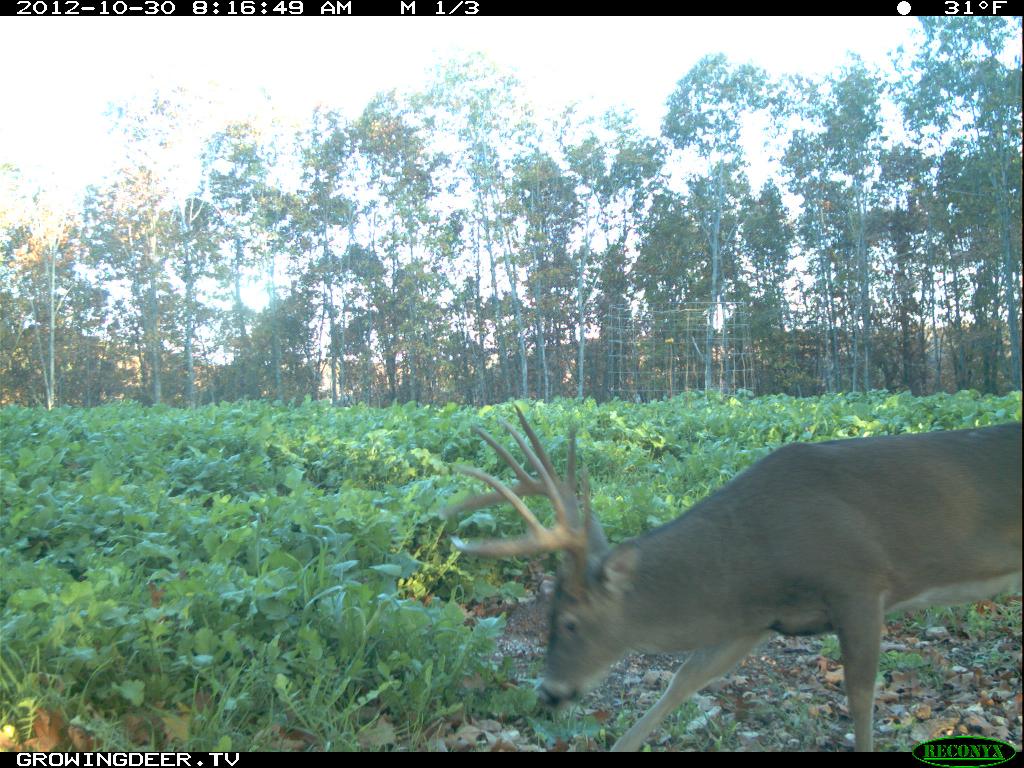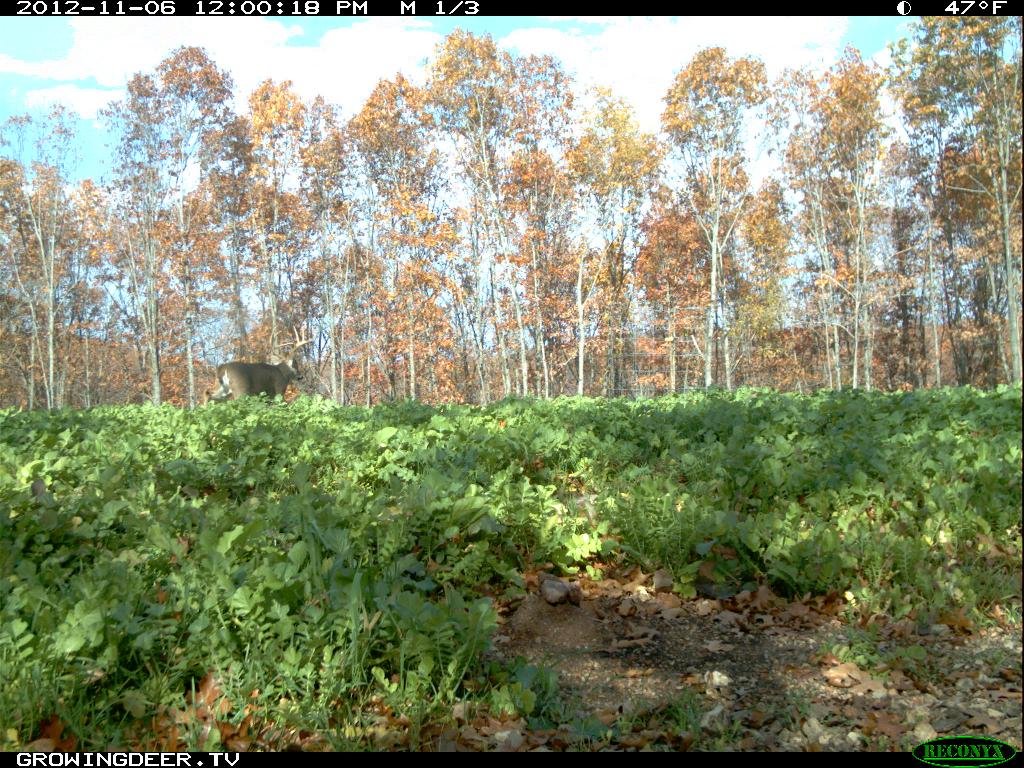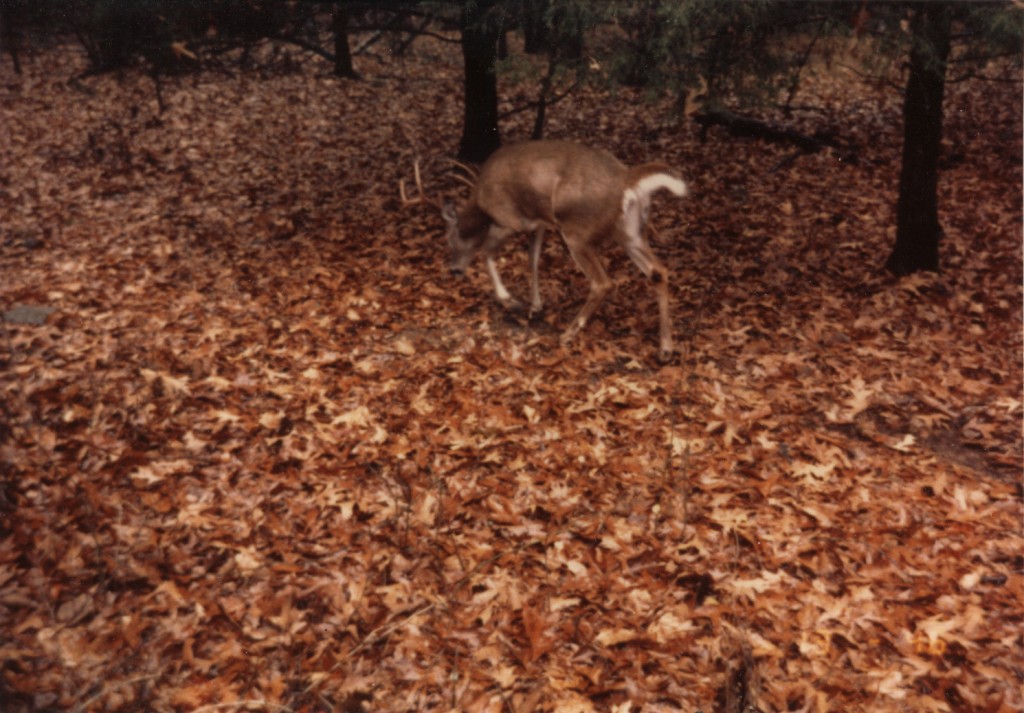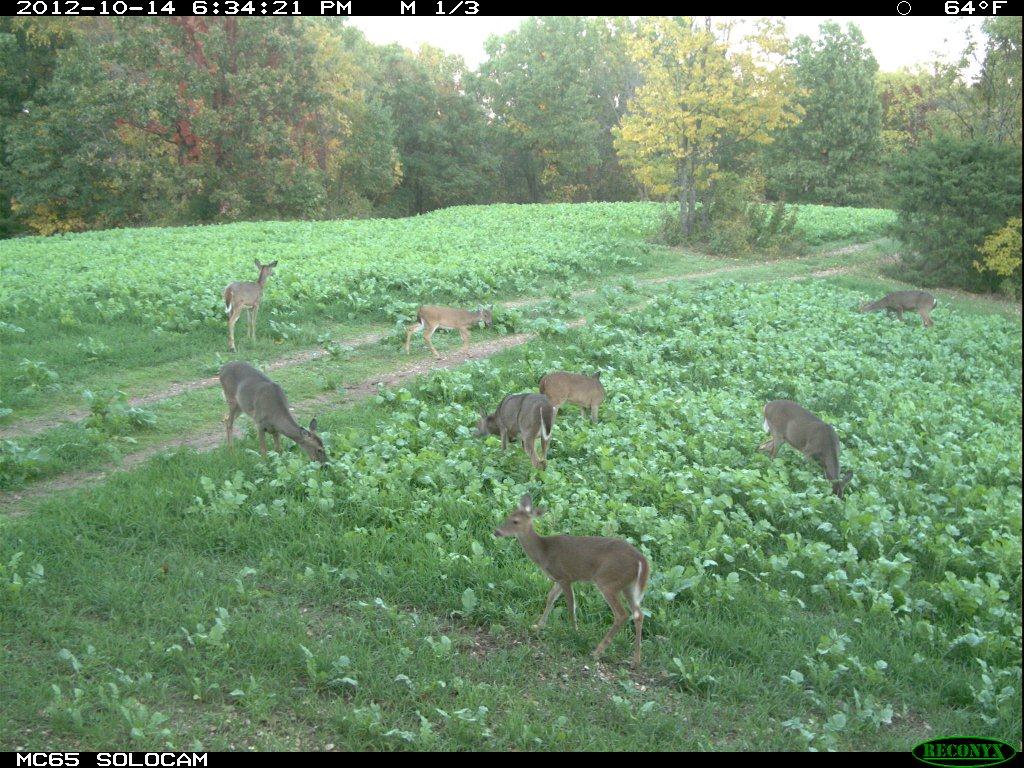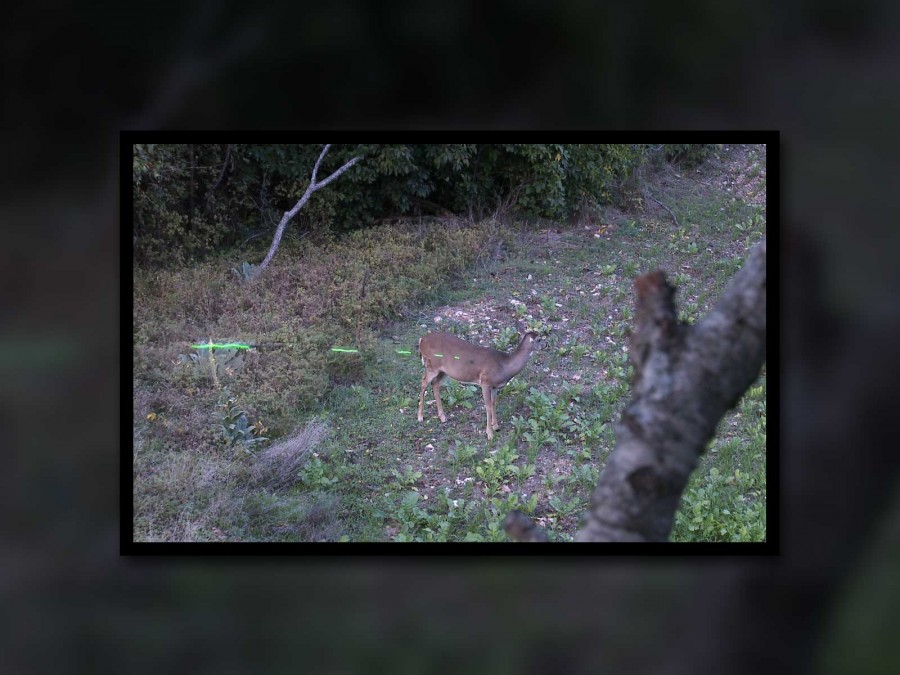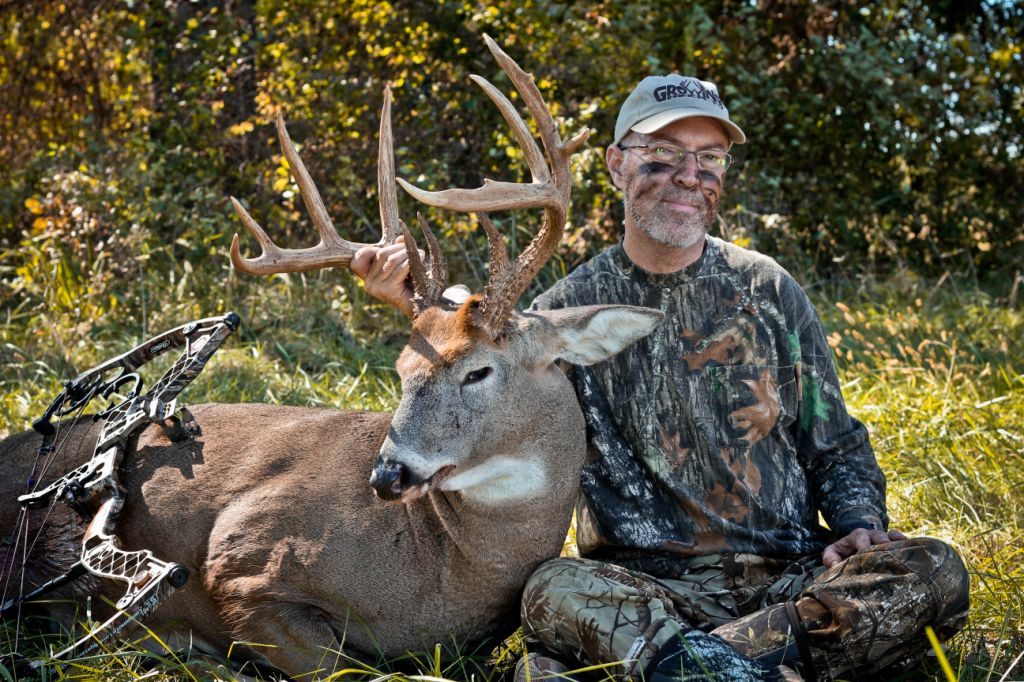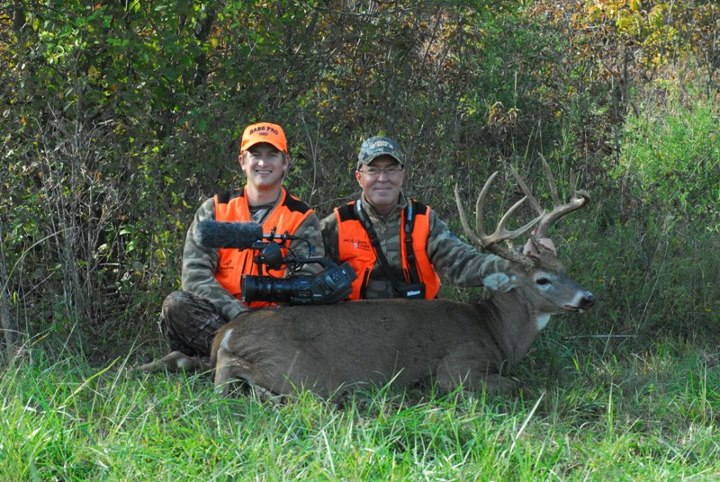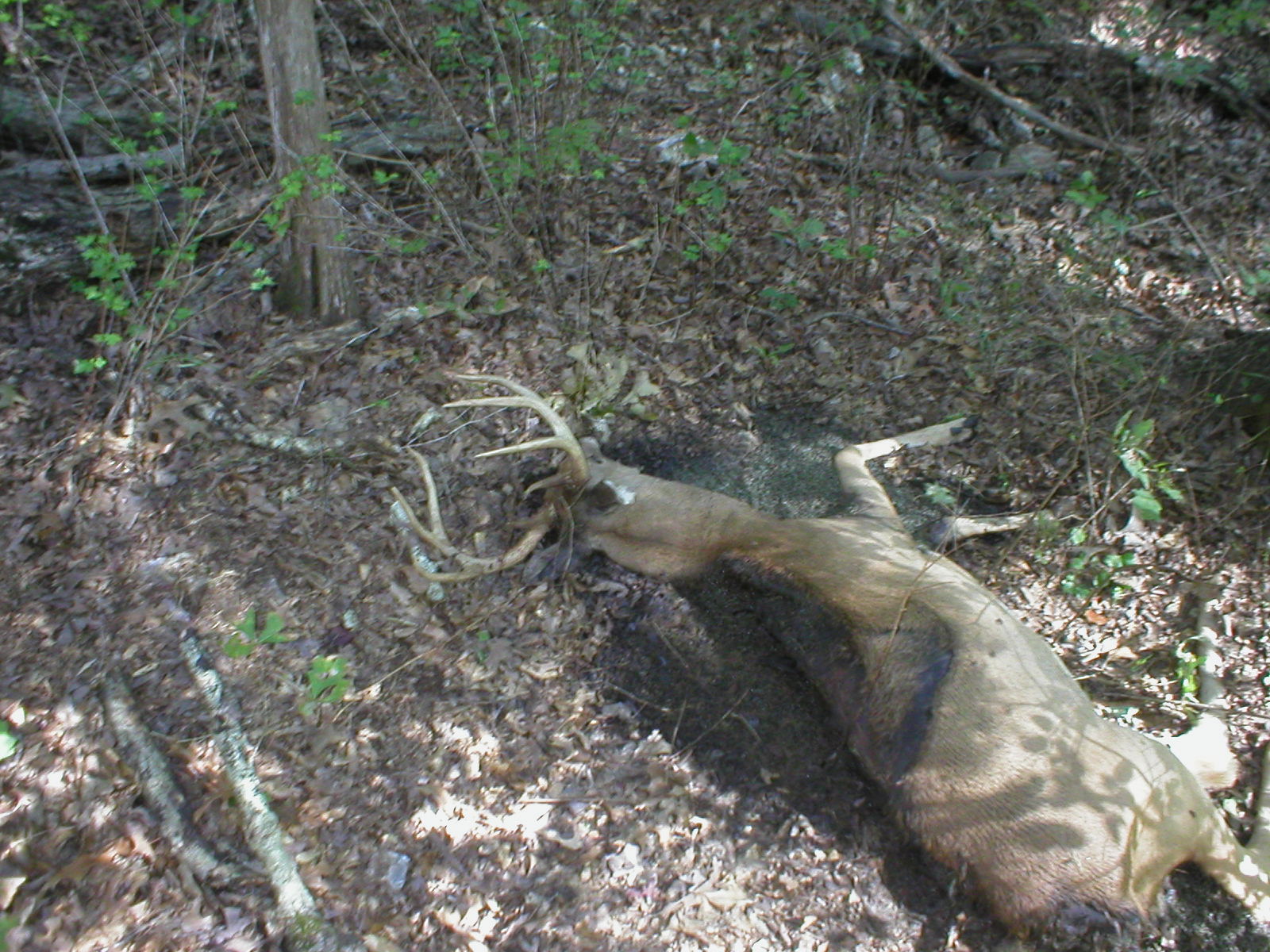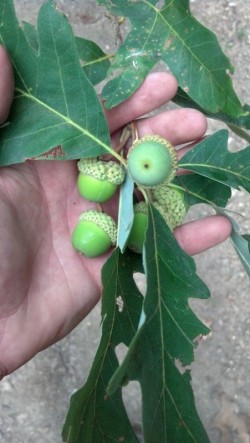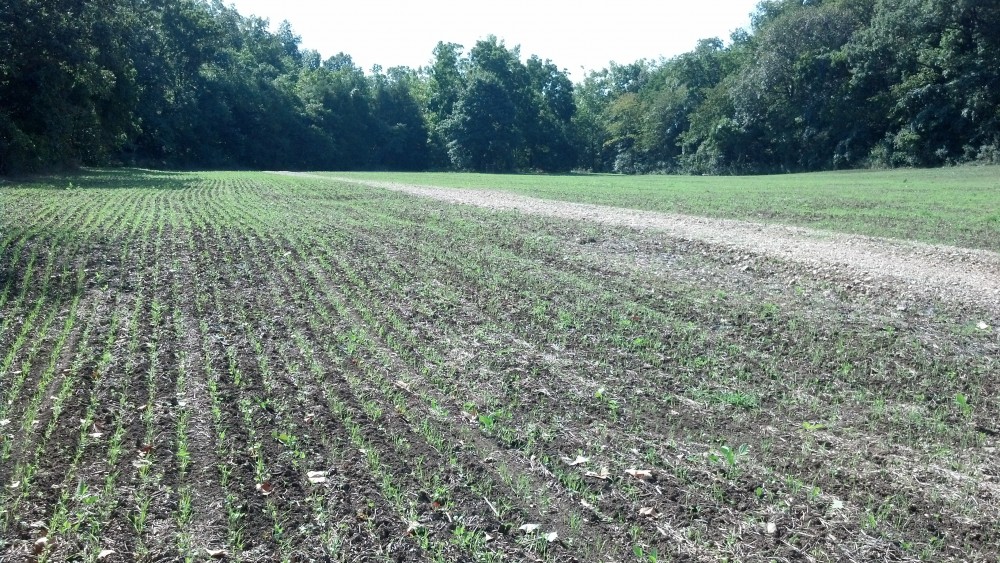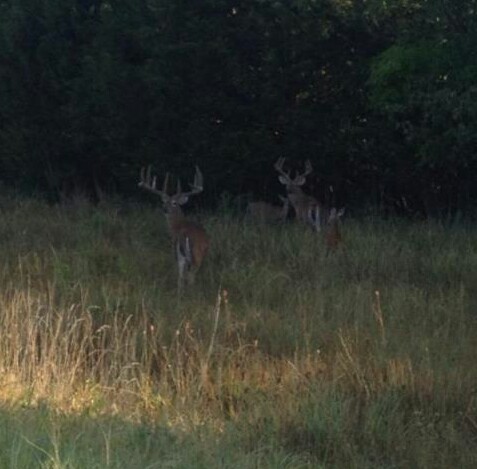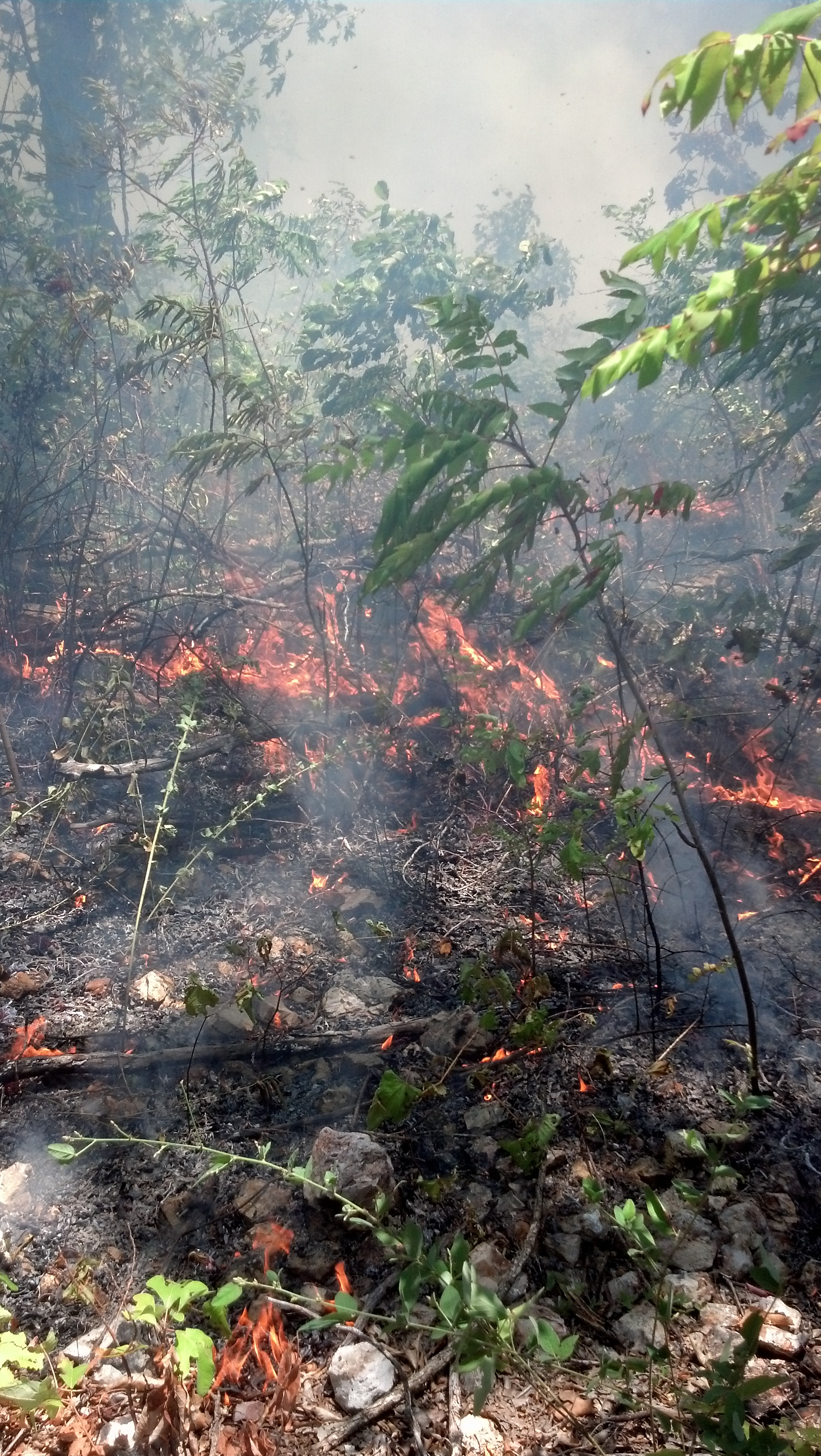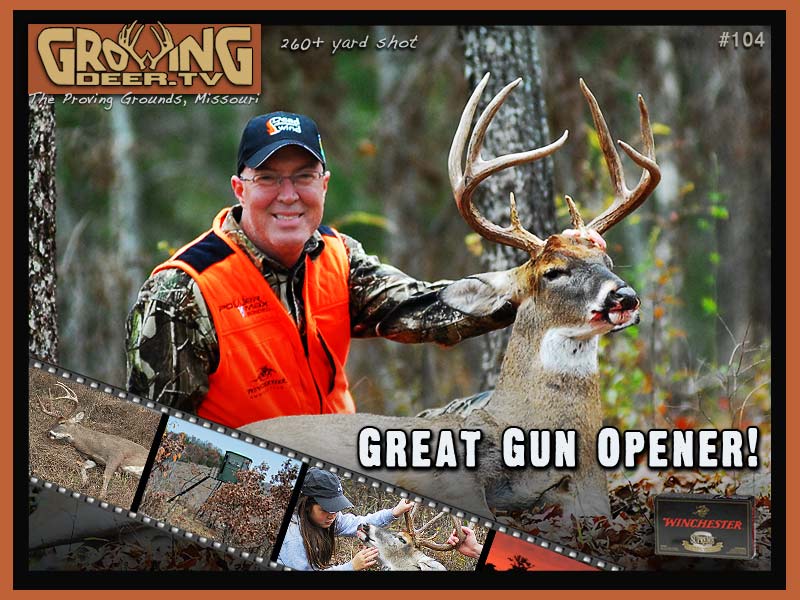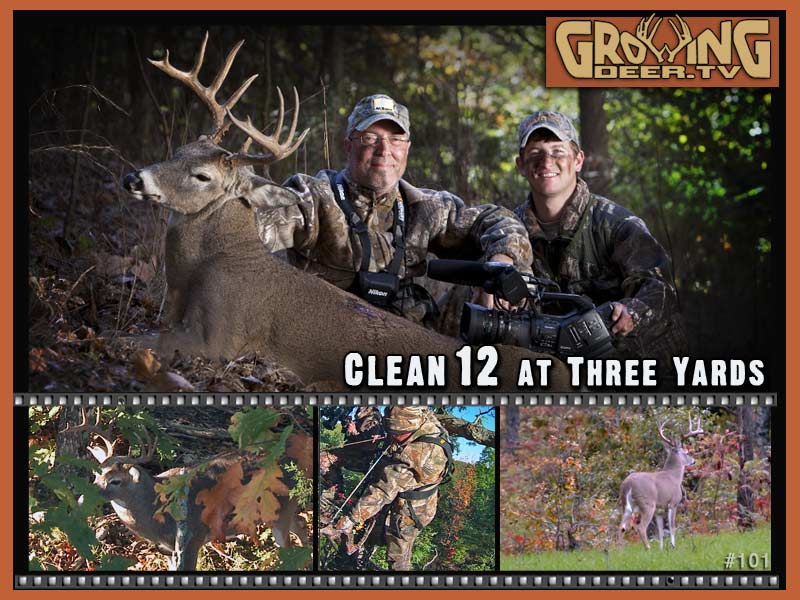Category: Deer Hunting
Hunting Strategies: What I Don’t Like About the Rut!
I enjoy hunting the rut! I’ve hunted everyday this week and have seen deer every time out! What’s not to like about those odds? It may have something to do with where I hunt. I hunt a property that is primarily covered by oak timber. I’m sure mature bucks are seeking/chasing does as aggressively here as they are throughout most of the Midwest. Then why am I not seeing mature bucks? The answer is simple. In areas where the primary land use is agriculture crops, deer often stick to the areas with cover, even when searching/chasing does. The areas with cover are limited, therefore where deer are traveling and stand locations are easy to find!
When cover is the primary habitat type, deer simply don’t have to venture into the open except to feed on forage that requires sunlight reaching the ground. If there are plenty of acorns in the timber, then deer don’t tend to use the forage plots often – especially during daylight.
Bucks will cruise through food plots, and other openings during the rut, but not on a predictable pattern. The two pictures in this blog were from 700+ images from October 30th through November 8th. Hunting there would have produced some excitement related to seeing a mature buck only twice.
Data like this is why I hunt primarily known travel corridors (such as ridge tops where the topography is steep), etc. when hunting woodland habitat. Any type of bottleneck due to cover, topography, water, etc., can be an outstanding location during the rut.
Deer can also be relatively easily patterned during the late season when most acorns are gone and deer are hungry and trying to maintain/regain body weight. The late season can be a great time to pattern mature bucks, especially if there is quality forage/grain that hasn’t been hunted so much during the early season that deer associate the area with danger and only feed there at night.
The rut can be a very exciting time to hunt, especially if you hunt in an area where the primary land use is ag and most of the crops have been harvested by mid October. If the land use where you hunt is primarily timber and there are quality forage/grain crops in food plots, then the best time to pattern a mature buck will probably be during the late season when the food supply is limited and easy to scout.
It’s always about being able to identify and hunt the limited resource. Receptive does are the best limited resource during the rut. They are tough to pattern as they often change the portion of their range they use for 24-36 hours when they are receptive. That’s why the best odds to harvest a mature buck during the rut are to hunt cover where it is limited and travel corridors where cover is the primary land use.
Growing Deer together,
Grant
What Stage of the Rut is Occurring Where You Hunt?
This is a common question among hunters this time of year! Are mature bucks moving during daylight? Are bucks using scrapes, seeking does, chasing does, or are does receptive?
By making a few observations while in the field hunters can get a good indication of the stage of the rut where they hunt! The adult sex ratio is a huge factor in the intensity of the rut. One of the first considerations is the past adult deer harvest sex ratio. If primarily bucks have been harvested and you typically see and/or have trail camera pictures of mostly does from your area, then don’t expect a rip-roaring, mature bucks cruising everywhere type rut. If there are substantially more adult does than bucks, the bucks won’t have to travel very far to find a receptive doe. Your observations of rut behavior will likely be very limited if you hunt a herd where the adult sex ratio strongly favors does.
If you and the other hunters where you hunt have harvested deer with a goal of creating and/or maintaining a balanced adult sex ratio and allowed a large percentage of the bucks to live to at least three years of age, then you have the opportunity to experience a hunt with deer expressing a lot of rutting behavior.
In such areas, the first sign I look for is lots of scrapes being actively used. The scraping stage of the rut occurs between when bucks shed their velvet and before a majority of does are receptive. Certainly bucks, does, and fawns may use scrapes, especially the licking branch, throughout the year. However, the vast majority of marking and checking the ground portion of scrapes occurs between velvet shed and when a majority of the does are receptive. If you are seeing lots of fresh scrapes – the chase phase of the rut is probably one to three weeks away at that location.
After the scrape phase, its’ common to see (in person or on trail cameras) mature bucks actively walking with purpose. They seem to be going somewhere. They are not taking a few steps and stopping to eat or check for threats (normal mature buck behavior). This is the seeking stage. Mature bucks are moving – but very few chases (bucks chasing does) are observed.
The seeking stage often changes to the chasing phase within a few hours or days. During this stage all bucks (unless they are injured) will actively chase does that are receptive. It’s common to see multiple bucks chasing a single doe. A more common observation during this phase of the rut is to see fawns without a doe. Does tend to abandon their fawns while they are receptive to breeding. If you are hunting and see several fawns without does (and it’s not because a substantial doe harvest just occurred), you know two things: the chase phase is on and the receptive does (and therefore the bucks) are using a different area. You probably need to change stand locations!
I’ve asked the GrowingDeer.tv Team that uses our Facebook page to keep us updated on the stage of the rut they are seeing – real time useful information to help those that haven’t been in the woods for a few days. This is a very exciting time to hunt! Join us on Facebook and get up to date information!
Growing (and hunting) Deer together,
Grant
Stage of the Rut
Adam and I just returned from hunting with the guys at Foxworthy Outdoors in Georgia and at the Kentucky Proving Grounds. At both places almost every doe we saw was with fawns. Does typically separate from their fawns before they become receptive to bucks. Seeing most does with fawns is a reliable sign that most does are not receptive to bucks. In addition, the only mature bucks we saw were just at dark or while going or returning hunting (before sunrise or after sunset).
The bottom line is that we didn’t see any signs of pre-rut activities. We did see several scrapes and rubs. All deer in the herd, bucks, does, and fawns use scrapes throughout the year. They certainly use scrapes more during the early portion of the pre-rut than other times of year. Some of my buddies in northern states have seen a few bucks scent checking does. The temperatures have been cooler in the northern states and I suspect the bucks are feeling a bit more like chasing.
I predict that the next cold front will bring an explosion of pre-rut behavior! I’ll be hunting food sources or stands that are best for the early season pattern of deer moving between food and cover until the next cold front. About a day before a cold front is predicted to reach my place, I’ll start selecting stands in travel corridors, etc. Once the bucks start seeking does, travel corridors that have a history of being used during the rut will likely offer a better chance of being used during daylight by mature bucks than those areas used by deer during the late summer for food or cover.
I live and hunt mainly in southern Missouri. If you hunt in the deep southern states it will likely be awhile before you need to switch hunting strategies. If you hunt north of Missouri, I suspect deer are already displaying pre-rut behavior.
If you would like my current observations about the stage of the rut, you can check my Facebook page as I’ll regularly share my observations.
Growing (and hunting) Deer together,
Grant
Bow Hunting Whitetails: String Jumpers
It’s early in the 2012 bow season. October 1st Brian and I went to a stand we call Boom North. It hadn’t been hunted this year (or most of last year). Using the Reconyx time lapse feature, we had a pattern of deer entering the food plot by the stand and the wind was predicted to be favorable that afternoon.
I told Tracy (my wife) that I’d be late as I expected to tag a deer that afternoon. Once in the stand, Brian and I noticed the winds were swirling. We’ve come to trust our scent control system as we’ve had some great experiences already this year (GDTV 149).
We’d only been in the stand about 20 minutes when I heard a deer behind us in the forest. Brian and I caught a glimpse of a deer through a hole in the treetops (the ridge slopes down steeply from the stand). It took more than 10 minutes for the first deer to enter the field. Either our scent was going over the deer or our scent control was working perfectly!
The doe held up just behind a limb blocking a clean shot. During the next 10 minutes four more deer entered the plot. None of them offered a broadside shot. Brian and I were in ready posture for 38 minutes before we had the option of a broadside shot. The doe was head down and eating when I drew. She was 31 yards away and seemed relaxed.
When I released the Muddy BloodSport arrow and watched the green Nockturnal nock speeding toward the doe, I had the same feeling as when you shoot a basketball and know you ripped the net long before the ball gets to the goal. Then, in disbelief I watched the doe drop and my arrow just miss the top of her back. All deer scattered and my confidence drained.
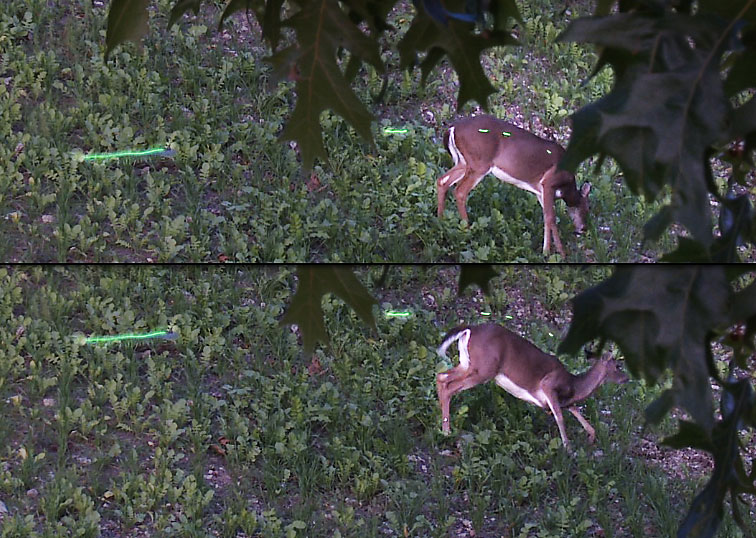
The top shows where the arrow would have been had the doe not dropped. The bottom shows what actually happened.
About ten minutes later one of the does returned to the plot. When she offered a 22 yard broadside shot, I tried again. That resulted in a short drag and tenderloins in the freezer! What was the difference?
The speed of sound is about 4 times faster than my bow shoots an arrow. Hence, if the deer is alert and reacts to a sound, they typically drop their body to prepare to sprint from the source of the sound. If you watch the video, you will notice the doe didn’t start dropping until the arrow was well under way. After being within 40 yards of two hunters for more than 30 minutes the doe was alerted by our presence. I’m amazed she hadn’t busted us earlier given the swirling winds. Once again the scent control system we use seems to be working!
The first doe apparently was alert enough to react to the sound of my bow and obviously had ample time to react and dodge the fate of becoming tenderloin for the Woods family. This was a great reminder to not shoot at deer that seem alert with a bow. Unless you are shooting the fastest bow on earth (1,100+ feet per second) deer can dodge the arrow – or worse yet, cause the arrow to hit a non-vital zone.
Tracy wants more tenderloin for the freezer, so I’ll be back in a tree soon – making sure to not shoot at deer that are alert.
Growing Deer together,
Grant
Scouting Whitetails: How Locating Small Game Leads to Harvesting Bucks
It’s September 28th and Grant and I have already been lucky enough to get a great buck on the ground! Last week we took a trip to the great state of Kansas, where Grant had been drawn for the early muzzleloader permit. The conditions were very enjoyable, with temperatures generally only reaching the mid to upper 70s. Unfortunately, the night time temperatures weren’t getting much lower than 60 degrees, meaning the deer still weren’t moving a lot during daylight hours.
The first two days of our hunt were slow, with only a few encounters. The main highlight happened on the evening of day two when the landowner, Grant, and I made a quick approach to a field right before dark and found a bachelor group of bucks. One was a nice looking buck, but after some further examination he was only three and a half years old. During day three a front was coming through and was causing the winds to shift from southeast to northwest. Great news for us! But also with this cold front, the night time temperatures were predicted to drop to the upper 30s! Now we had a westerly wind and what was predicted to be the coldest night of the fall. Now we were in the game!
With the weather changing and a westerly wind, Grant and I could enter into a proven (and favorite) spot. This small field had large wheat fields to the west, a bedding area to the east, and it was surrounded with large oak trees. The large oak trees had produced acorns in the past helping Grant harvest a nice buck just two years earlier (GDTV 48).
On the third night the wind was predicted from the northwest so Grant and I eased to the field edge from the southeast. While making our approach down a small road we were noticing scrapes and rubs, something we hadn’t seen much, if any, of prior to that evening. Our hopes were high and they started to get higher when Grant and I sat staring across the field listening to the constant sound of squirrels and turkeys in the woods surrounding the field. This meant one thing. We had found the main food source for the squirrels and turkeys. We just hoped it was the same for the deer, and judging by the amount of deer sign walking in it certainly was. That evening ended with only a couple doe sightings but the temperatures weren’t forecasted to drop until that night.
The next morning the temperature stepping out of the truck was 35 degrees, the coldest morning so far this season. The wind was almost non-existent, so we knew thermal winds would play the more important role. We approached from the north and set up on the northeast end of the field, letting the thermal winds pull our scent downhill and away from the field. The morning was crisp and cool but was surprisingly slow until 8 o’clock. By this time the sun was up and starting to shine on the field, causing the thermal winds to begin shifting towards the field. Not good for us. We quickly decided to ease along the edge of the field to the south side, putting the wind back in our faces. Before I completely give the story away I’ll mention the three key elements to our success and let you watch it all unfold on the next episode.
Locating small game species was essential to this hunt
Not ruining the spot before the conditions are right
We didn’t hunt the field until the wind was in our favor, we could have gone in on day one of the hunt and contaminated the area with our scent, ultimately leading to no success.
Locating the food source by finding the squirrels and turkeys
When Grant and I entered on night three we could hear the turkeys and squirrels in the woods, but we never entered the woods to make sure there were acorns on the ground. We trusted our ears and left the woods untouched.
Using a Scent Control System
As you watch the hunt unfold, you’ll notice the deer placing their nose in the air trying to catch wind of something. That something is us, the predators! I mentioned the thermals switching on us as the morning progressed — this buck knew something was up but could never put his nose on it. Literally! If it wasn’t for a constant use of Dead Down Wind products and our ScentMaster system this hunt would have never been a success.
While sitting in your stand this week take some time and listen for turkeys and squirrels and see if you can locate their feeding area. Chances are that is where the deer are feeding also!
Dreaming of Giant Whitetails together,
Adam
Hunting Whitetails: How Will EHD Affect Hunting?
Literally 1,000’s of bucks, does, and fawns have been found dead during the past few weeks from South Dakota to North Carolina. The likely cause of death is EHD (Epizootic Hemorrhagic Disease) or BT (Blue Tongue).
For more information about these viruses read the epizootic hemorrhagic disease fact sheet.
The only known method to stop the deaths from EHD is a killing frost that will kill the flies that carry the virus from deer to deer.
I’ve received several questions asking if hunting should continue given the extent of EHD. There isn’t a black and white answer that covers all areas. In my home state of Missouri, there have been no deer found that were suspected to have died from EHD or BT in some counties. In other counties more than 100 dead deer have been found.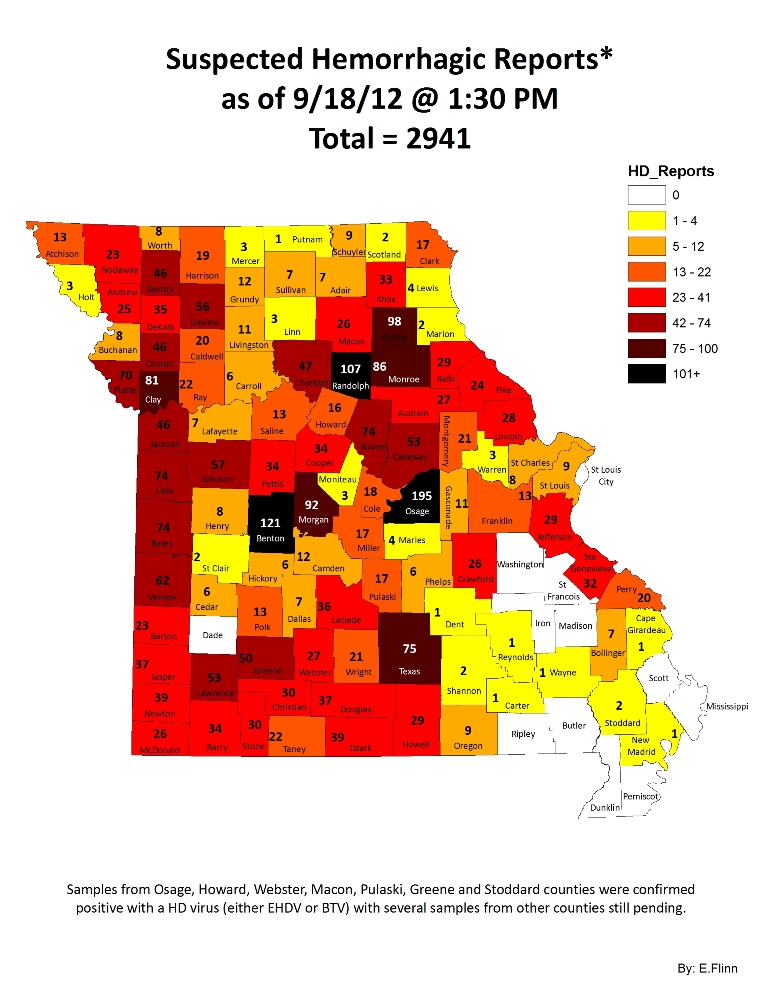
Dead deer tend to decompose or be consumed by predators/scavengers rapidly during the warm days of late summer. Hence, the number found and reported is likely a gross underestimation of the total killed by the viruses. It is doubtful state agencies will have the resources to survey deer herds in localized areas. Certainly they won’t be able to survey the herds before the 2012 season (which has already begun in some areas).
There are exceptions. South Dakota’s Game, Fish, and Parks department is offering a refund for 2012 deer licenses. They state they may make further adjustments as needed. However, this action won’t be required by most states. The impact of the virus will vary by location. This is why each hunter and/or land manager needs to assess the impact in their area and set their harvest objectives accordingly.
Whether there is a die-off or not, deer herd harvest objectives should be based on the ratio of deer to the amount of quality habitat available. If you hunt/manage deer in areas with lots of row crops, then food is rarely a limiting resource. If you hunt in areas that are primarily timber and/or pasture, then the deer population must be kept smaller so the number of deer doesn’t exceed the habitat’s ability to produce quality food.
I have a friend that owns and hunts 75 acres. He’s already found 5 dead deer (including the largest buck that he knew was using his property). Based on camera surveys and observations, probably 1/3 of the deer that used his property have already died. It is 20 days before it normally frosts where he hunts. It is very possible that another 1/3 of his herd could die before a frost kills the flies that carry the virus from deer to deer. It may be best for my friend to not harvest deer this year – depending on what happens during the next few weeks.
That prescription should not be automatically accepted for other areas. However, it should serve to make hunters and landowners aware that this year may not be business (deer harvest) as usual. I strongly recommend all hunters and landowners to observe the number of deer in their area. Visit with neighbors and other local hunters and get their observations.
My friend has already taken steps towards helping his deer herd recover. Yesterday while out checking for deer sign, he shot a coyote. Predation can have a larger impact on suppressed deer herds compared to those that are near the habitat’s capacity. If you’ve never been a predator hunter, this is the year you should seriously consider becoming one.
I’ll be using my Duke Traps and Fox Pro caller this year. I expect to have a busy year as I have a lot of friends that may need a bit of help removing some stress from their surviving deer herd.
Growing Deer together,
Grant
Bow Hunting: Early Season Plan of Attack
It’s September 14 and we’re only one day away from the opener of Missouri archery season! SAWEEEET!!! The wait is almost over, and all the preseason preparation is about to be put to the test. There are the months of shooting your bow, hanging and trimming treestands, washing your clothing, planting food plots and possibly looking through thousands of Reconyx images, all for the hopes of tagging a trophy buck! Now that the season opener is knocking at our door, I’m sure we’re all drawing out a game plan. If you’re in an area that has a great acorn crop you’re probably planning on heading into your best oak stand. Those of you in areas dominated by crop fields, you’ve probably spent the summer glassing bucks in velvet and will find yourself sitting on the edge of the field somewhere with high expectations. As of a week ago Grant and I were planning on being in the woods listening to acorns fall, but with recent scouting our plan has changed!
Throughout the summer we’ve located several big red and black oak trees with lots of acorns on them. As the acorns have matured and began to fall we’re noticing more and more uneaten acorns lying on the ground. While working this morning spreading some Deer Trac, I noticed a lot of fresh browse on young soybeans and wheat, and a very large amount of tracks around. This certainly fits the definition for M.R.I. (Most Recent Information) so Grant and I will find ourselves staring at a nice Eagle Seed Buck Monster Wheat food plot on Saturday afternoon hoping for the chance at a hit list buck!
Good luck to all my fellow bow hunters who will be hitting the woods this weekend and in weeks to come! Be safe and always have fun!
Dreaming of Giant Whitetails together,
Adam
Scent Control: An Essential for Consistently Harvesting Mature Bucks
Last week I explained the importance of hunters reducing scent on them and their gear so they don’t alert mature bucks. This week I wished to share the system I use to accomplish this goal.
A good scent control system should reduce enough of the scent of a hunter and his gear so that bucks will approach the hunter close enough to allow for an ethical shot. It’s not just mature bucks that we need to worry about alerting. Spooking a doe or immature buck can alarm a mature buck enough that they won’t approach the area.
Given the wariness of most mature bucks and knowing that strange scents, or scents they associate with danger can cause them to go on high alert or change their path of travel, it’s critical that the scent reduction program covers gear and hunter from the time they go to their stand until they kill or exit the hunting area.
To accomplish this, Adam and I use the Dead Down Wind system. We wash our clothes with their soap. I use Dead Down Wind because it is enzyme based – not a bactericide. Dead bacteria often put off strong odors (ever smell a swamp?). I wish to break existing bacteria down and limit certain types of bacteria from growing on me and my gear.
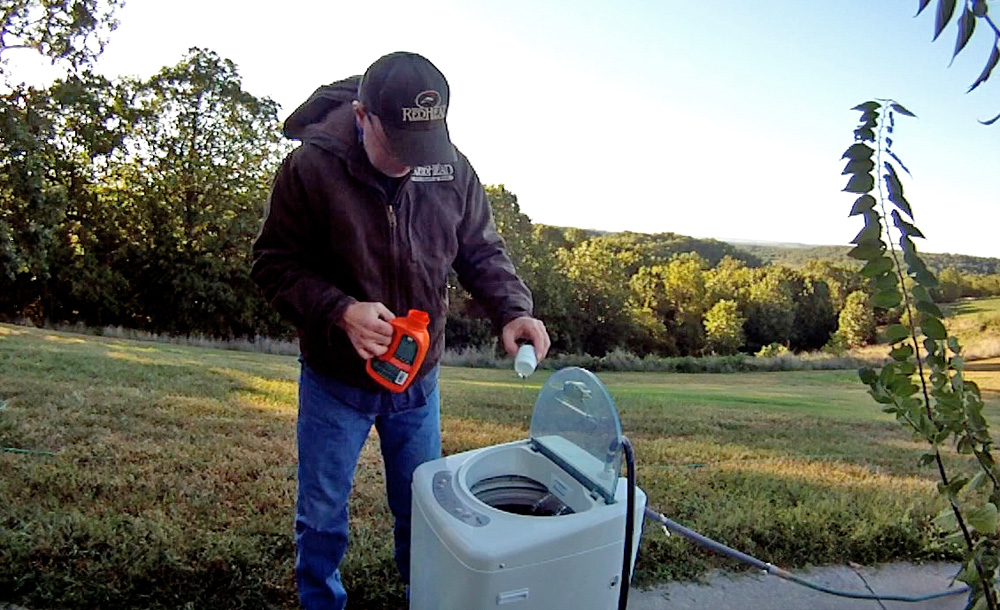
Doing laundry with Dead Down Wind ScentPrevent laundry detergent is an essential part of my scent reduction system
It doesn’t do much good to reduce the scent and odor causing agents on your body and then use a towel that is full of perfume, fabric softener, etc., which will simply apply a scent that is just as alarming to your body. Hence we buy some towels that are only used to dry ourselves when we are preparing to hunt. They are laundered, stored, etc. just like our hunting clothes.
Likewise, it does no good to remove odors from hunting clothes and then store them where they can absorb household and other smells that will alert deer. I prefer to air dry our clothes outside. If we are staying at a friend’s house we may use the dryer if there isn’t a place outside to air dry our clothes away from sources of odor (such as cars, lawn mowers, etc.).
Once our clothes are dry, we store them in a ScentMaster box. This clever device is a closed air system with a strong fan and air heater. It recirculates 130 degree air through the box and a large carbon filter. The warm air insures the clothes are totally dry and is not a friendly environment for smelly bacteria, mold, etc., to grow. This is a great method to store hunting clothes, and remove some odor that may have built up between hunts.
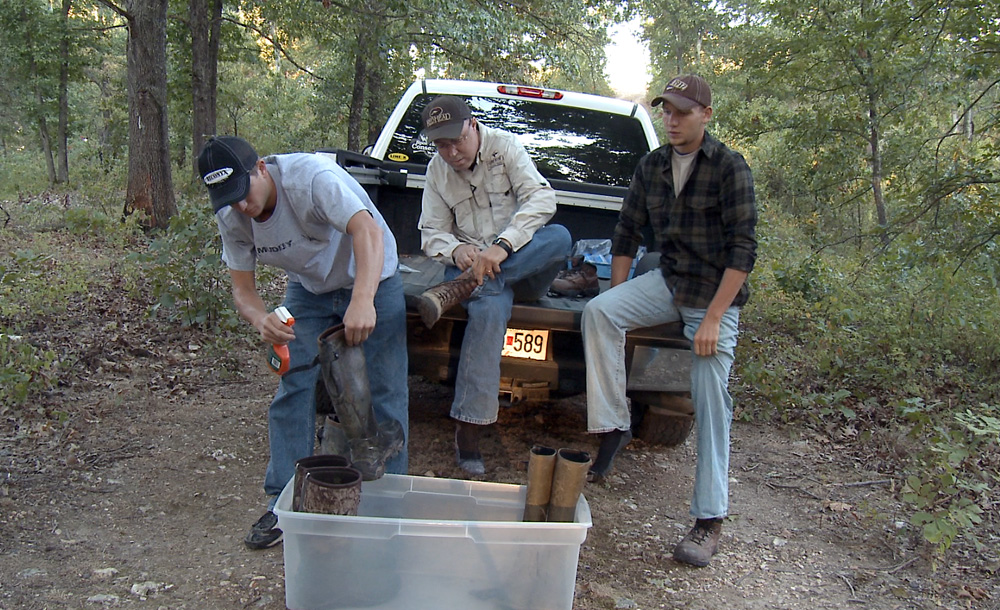
Applying Dead Down Wind ScentPrevent field spray before hunting leads to greater success at harvesting mature bucks
We’ll tote the ScentMaster box to our hunting location and change into our hunting clothes just before walking to our stand. Before we get dressed, we use the Dead Down Wind field spray to ensure our bodies, clothes, and gear are scent free as possible before heading to the stand. If we’ve been backpacking and/or camping we use the Dead Down Wind foam as an infield shower. The foam dries rapidly and is a great substitute for a shower.
Likewise we use the Field Spray to remove odors from our Nikon binos, range finders, etc.
Adam and I have filmed and killed several mature bucks while using our system of reducing scent. It’s certainly not fool proof. Such claims to the contrary are most likely false. But for most hunting situations, it’s proven to be very effective.
We produce a new episode each week – 52 weeks a year. We don’t have time to go on three hunts and only show the results of the best. You can see for yourself how well our scent reduction system works each week by simply watching GrowingDeer.tv.
Growing (and hunting) Deer together,
Grant
Preseason Preparations with a Giant Whitetail
It’s August the 23rd. I’m starting to have that feeling that can only be compared to the night before Christmas when I was a child. There wasn’t much sleep happening because the excitement was almost too much to bear. Plus, what little rest I did get was filled with dreams completely engulfed with new toys, stockings and reindeer. Years later I’m still dreaming about deer, but this time it is whitetails! Lately I’ve become so entangled with the upcoming season opener (September 15th) that I can’t even go to sleep without thinking about it. The good news is, I’m not alone. In fact, just this week Grant shared with me that he has started his usual preseason dreams about hunting whitetails. This is something that is often true with deer hunters.
To make this problem worse, last week I received a photo from a close friend of mine with a GIANT buck he had seen standing alongside the road in Missouri. At first glance, you’ll probably do the same thing I did and assume it is a fake or in a pen. After some questioning, I finally came to believe his story. Check it out!
Did you notice the second buck standing behind that monster? At first I overlooked him. That buck isn’t too shabby either. He was just dwarfed because he was standing next to a GIANT! Out of respect for the landowners and hunters in that area I won’t give any specifics. This definitely gets me pumped for deer season.
Even with all this talk of deer season we’re still continuing to manage the wildlife habitat here at The Proving Grounds. This week we had a little fun with a woodland/glade prescribed fire. With a “summer burn” or “late growing season burn” we are helping the wildlife by stimulating the future growth of forbs and killing the many small saplings that have tried to take over the glade. Our goal was to kill as many small saplings as possible while not killing any large, mature trees in the process. We safely accomplished our goal and now are planning our next fire for (hopefully) sometime next week.
It’s that time of year! Whether you’re out scouting fields for bucks or practicing prescribed fire keep your eyes peeled and a camera handy. If you see a buck like my friend, you don’t want to miss an opportunity for a photo! If you do capture a cool photo, and want to share it, head over to Facebook and post it! We would love to have our Facebook page covered with photos taken of giant whitetails so we all could dream together! With a little luck maybe those dreams could become reality for all of us!
Dreaming of Giant Whitetails together,
Adam
Warning: This blog contains information about prescribed fire which is a management tool for trained professionals using the appropriate tools for the situation.
Scouting for Mature Bucks, Pt. 2
- Determine if mature bucks are in the area
- Learn which mature bucks move more during daylight
- The locations of food, cover and water within their range
Those are good steps to patterning and harvesting a mature buck. However, stopping there doesn’t provide me enough information to locate a deer blind with confidence I’ll be able to tag a mature buck. The final two steps in my scouting process include:
- Which habitat features (food, cover, and water) are most huntable under specific conditions
- Characteristics of targeted bucks
There are rarely large gaps in a mature buck’s survival strategy. Therefore my hunting strategy is to position myself at the right place and time to be able to take advantage of the few weaknesses in a mature buck’s plan to survive.
Deer need food, cover, and water daily. However, mature bucks often use the cover of darkness or areas where the wind swirls (is in their favor from all directions) during daylight hours to use these resources. Rather than simply hunt the sources of food, cover, or water within an area a mature buck is known to use, I determine which of these resources allows me to approach, hunt, and leave without alerting deer. Mature bucks primarily use large feeding areas at night during the hunting season on most properties. The more limited the food source (late winter, etc.) the more likely a mature buck will use it during shooting hours.
Deer spend more time using cover during daylight hours than any other time! Many hunters rarely hunt cover, but it’s my preferred resource to hunt. I wish to hunt where the deer are! I prefer cover that’s on an opposing slope when hunting with a gun. This allows me to see into the cover from a distance. This was the perfect strategy during the 2011 Missouri gun opener. I rarely hunt directly
in cover during archery season. Patches of cover should be much larger than bow range (even for an Olympic archer). Hence, I prefer to hunt travel corridors very close to cover during the morning. I can get close to cover before daylight with much certainty that the bucks will be out roaming. I approach the travel corridor, hugging the cover so I don’t alert deer that are feeding, etc. close to the cover. I spend the morning waiting on deer to return to the cover. This was a very successful strategy for me when I saw Clean 12 at Three Yards last fall!
Once these stand locations are found, I target bucks that have showed signs of being aggressive or bullies. These are bucks that dominate feed or Trophy Rock sites! Such bucks are probably more likely to respond to grunt calls, rattling, or decoys. It’s easier to attract a bully than a buck that simply wants to slide by without causing a fight.
By using these five steps, I’ve been able to pattern and harvest multiple mature bucks. I suspect if you will give them a try, you’ll have an opportunity to tag a mature buck this fall!
Growing (and hunting) Deer together,
Grant



